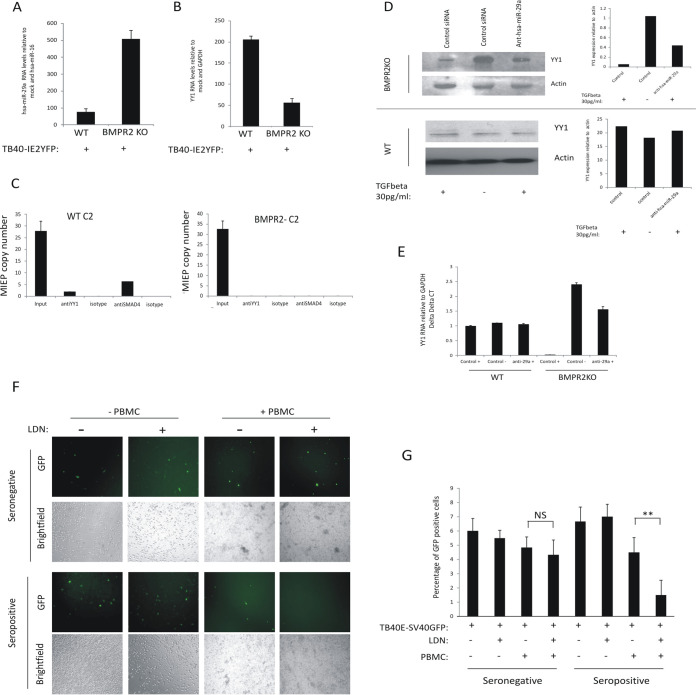FIG 5.
The absence of BMPR2 leads to a decrease in levels of YY1 mRNA during HCMV latency and a lack of YY1 occupancy on the MIEP. WT-iPSCs and BMPR2−/− iPSCs were latently infected with HCMV for 4 days before analysis for miRNA hsa-miR-29a and the housekeeping miRNA hsa-miR-16. Graphs represent triplicate mean delta delta CT values with standard deviation error bars (A). WT-iPSCs and BMPR2−/− iPSCs were either left uninfected or infected with TB40E-IE2YFP for 4 days before the RNA was harvested and analyzed for YY1 and housekeeping gene GAPDH mRNAs (B). WT-iPSCs and BMPR2−/− iPSCs were infected with TB40E-IE2YFP for 4 days before harvesting for ChIP analysis to detect YY1 association with the MIEP. Input samples were diluted 1:10, and the MIEP was detected by qPCR (C). Graphs represent triplicate mean values with standard deviation error bars. Finally, BMPR2 KO cells or WT cells (D and E) were transfected with control siRNA (control) or an antagomir to hsa-miR-29a (anti-hsa-miR-29a) in the presence or absence of 30 pg/ml of TGFbeta. After 48 h, cells were harvested for Western blotting (left, D) for actin and YY1 and bands were then analyzed by densitometry (right, D). Alternatively, cells were harvested for RNA. (E) Analysis of YY1 and GAPDH transcripts. The graph represents delta delta CT, with standard deviations shown. Finally, CD14+ monocytes were isolated from an HCMV-seronegative or HCMV-seropositive individual and remaining PBMCs were stored. The CD14+ cells were then infected with TB40E-SV40GFP and latency was established for 3 days. After this time, LDN was added to the cells as indicated for 24 h before addition of PBMCs at physiological effector-to-target (E:T) ratios (F and G). After 24 h, cells were analyzed by light and fluorescence microscopy (F) and GFP-positive cells were enumerated and presented graphically; standard deviation error bars are shown from 6 fields of view (**, significance value of <0.005 by Student’s t test; NS, not significant) (G).

